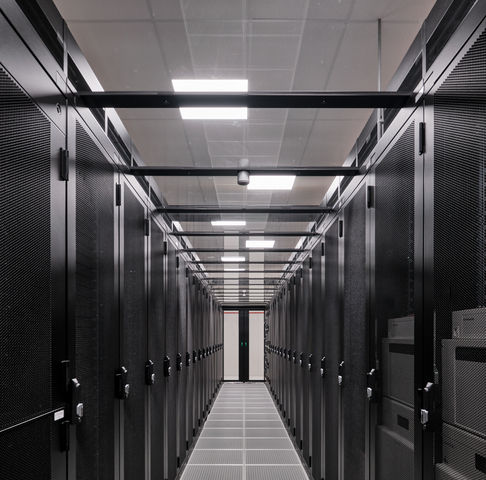The ongoing digitization of the economy and society is a development that can no longer be stopped. A characteristic of the current situation is that the playing field has changed considerably in recent years. The partly voluntary, partly out of necessity born emergence of hybrid working is creating a growing need for connectivity and reliable cloud solutions. At the same time, the climate crisis is forcing us to link speed and IT capacity to sustainability.
The above developments also have an impact on the way in which data centers offer their services. In this blog , we highlight the most important trends within data centers for 2022 and explain how to implement these trends.
The 7 data center trends for 2022
The great need for powerful IT solutions and reliable connectivity ensures that data centers will continue to play an important role in the economic and social field in 2022. In fact, the services of data centers are increasingly gettting more public utilities character. Time to take a closer look at the main trends that will determine the landscape of data centers in the short and medium run.
1. Accelerated digitization without concessions
IT end-users are becoming increasingly demanding, both in business and private life. Think of situations where you are streaming a movie, while your partner is meeting with his or her colleagues on Teams. Or when you hold virtual meetings that fully replace the weekly team meeting. These are applications that require high bandwidth, capacity and speed.
The increased demand for IT resources, combined with the massive migration to the cloud, is also creating more complex IT infrastructures. This is leading data centers to increasingly focus on automation and orchestration. As more and more data centers are software-defined, it becomes easier to quickly scale up services for large groups of users or periods with spikes in data traffic without much human intervention.
2. Greater focus on sustainability
Sustainability is now more than a trend: it is a point that is primarily on the agenda of companies and is touched upon by 80% of global companies (a few decades ago it was only 12%) in their communications. Data centers are also following this trend and, in order to reduce their ecological footprint, are increasingly using measures and techniques such as energy saving, reuse of residual heat, more efficient cooling techniques and renewable energy sources.
3. A more important role for edge computing
Everything and everyone is connected today. The rise of IoT, for example, is creating a growing army of devices that generate enormous amounts of data through smart sensors. Processing all that data through networks and connectivity solutions is a considerable challenge. Edge technology offers a solution, as it allows data to be processed at the edges of the infrastructure - and therefore close to the source.
According to Gartner, by 2025 companies will create and process more than 75% of all business data outside the traditional central data center. That's why modern data centers are investing heavily in remote infrastructure management solutions, intelligent hardware, and security and tracking tools for remote monitoring of networks and applications.
4. Hybrid and scalable architectures
Hybrid and scalable architectures are gaining popularity. These include a mix of on-premises, one or more private clouds and several public clouds. The data center of the future supports such a hybrid infrastructure by offering great scalability and freedom of choice. This manifests itself in the delivery of the right amounts of computing power and resources at the right time. The motto is to scale up or down quickly and on the basis of current needs. The services of data centers are shifting in the direction of 'Datacenters-as-a-Service'.
5. Modular construction
New data centers will more often be built in a modular way. This prevents problems such as a long construction process and sky-high investment costs. This modularity relates to both the technical components and the architectural design of data centers. The advantages of modular construction? Rapid deployment of resources, the ability to expand flexibly and more efficient energy use.
6. AI is advancing in the data center
Artificial intelligence (AI) is steadily advancing in the data center. This is reflected in part in the gradual shift from single-domain digitalization to full-lifecycle digitalization and automation. Data centers can use AI to make better predictions about workloads and expected peak periods. In addition, this technology can also be used to optimally route data and services, for example.
7. Security and reliability become even more important
As the number of smart IT applications and the dependence on digital solutions grow, so do the cyber risks. Security and reliability are therefore important assets for data centers. A modern data center must be robust, well secured and privacy-proof. It must also contain the tools and knowledge to adequately repel both physical intrusions and digital attacks. Extensive security analytics and network monitoring are therefore becoming increasingly important components of the data center manager's toolkit.

What does investing in these data center trends give companies?
Investing in the trends that are mentioned above has many benefits for organizations. For example, by choosing data centers that puts sustainability and energy efficiency high on your agenda, you will be satisfying a strong, widely-held social need. You help facilitate sustainable growth and strengthen the reputation of your company and brand.
Investing in a hybrid and scalable infrastructure not only gives you the ability to quickly scale up or down capacity based on current needs, but also grants you additional control over storing and managing data. Do you want to use the public cloud to host generic and frequently used apps? But prefer to manage business-critical and privacy-sensitive data on-premises, in a private cloud or in a traditional data center? That's no problem with a hybrid and scalable architecture.
Seriously betting on edge computing and AI gives connectivity a boost. Processing large data streams without sacrificing performance becomes a lot easier, especially since data is processed closer to the source. In addition, AI provides useful information on the optimal routing of traffic and expected peak periods. The importance of good security solutions, in terms of detection and prevention as well as mitigation, is abundantly clear at a time when networks are becoming more complex and cybercrime is a lucrative and professional business model.
Getting Started in Practice
But how do you practically get started with the trends that will be at play within the data center in 2022 and beyond? It starts with a clear picture of your wishes, needs and current IT structure. Here you can think of questions such as:
To what extent is your current IT infrastructure scalable and future-proof?
Is your IT landscape able to optimally exploit the opportunities of AI, IoT and edge computing?
Is the security level adequate to deal with modern cyber threats?
And what about the sustainability rating of the data center where you currently house your IT services?
Once you have a clear picture of your wishes, needs and current infrastructure, it is important to choose a partner who actively anticipates the current trends in data centers. A partner that uses the possibilities of modern technology to create an IT infrastructure that meets the highest connectivity, security and sustainability requirements. And it must be a party who can advise you on the architecture which fits in optimally with your business and IT landscape.
How does Eurofiber Cloud Infra help?
Do you also want to benefit optimally from the data centre trends which will play an important role in 2022 and subsequent years? Then with Eurofiber Cloud Infra you have come to the right place. Among other things, you can count on us for the following facilities and functionalities:
Great attention to sustainability. For example, we use energy-efficient cooling techniques, cold corridors, green energy and an energy-efficient UPS installation. Moreover, we recycle and reuse residual heat.
Our hybrid data centers offer the best of multiple worlds by combining the capabilities of the public cloud, private cloud and on-premises.
With a Twin Datacenter solution, you house your IT infrastructure in two geographically separate locations, but with the same reliable party. This guarantees extra stability and security.
Thanks to our cooperation with various carriers, good connectivity is never a problem again
Would you like to know more about Eurofiber Cloud Infra?
Would you like to know more about Eurofiber Cloud Infra's services? And are you looking for advice? Then feel free to contact us without obligation for a (virtual) introduction.
